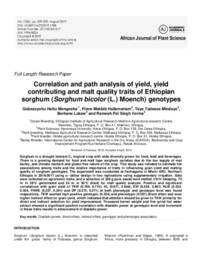Correlation and path analysis of yield, yield contributing and malt quality traits of Ethiopian sorghum (Sorghum bicolor (L.) Moench) genotypes

Authors:
Sorghum is a drought tolerant C4 tropical crop with wide diversity grown for food, feed and beverages. There is a growing demand for food and malt type sorghum varieties due to the low supply of mat barley, and climate resilient and gluten free nature of the crop. This study was initiated to estimate the associations among traits and the relative importance of traits in influencing grain yield and malting quality of sorghum genotypes. The experiment was conducted at Fachagama in Mhoni ARC, Northern Ethiopia in 2016/2017 using α- lattice design in two replications using supplementary irrigation. Data were collected on agronomic traits, and a selection of 300 g pure seeds were malted (18 hr steeping, 72 hr in 28°C germinated and 24 hr in 50°C dried) for malt quality analysis. Positive and significant correlations with grain yield of TKW (0.766, 0.715), KL (0.671, 0.644), KW (0.524, 0.491) HLW (0.532, 0.504, FHWE (0.257, 0.241) and DP (0.275, 0.271) at both phenotypic and genotypic level was found respectively. TKW exerted high positive genotypic (0.334) and phenotypic (0.287) direct effect and even higher indirect effect on grain yield, which indicated that attention should be given to TKW primarily for direct and indirect selection for yield improvement. Thousand kernel weight and fine grind hot water extract showed a significant positive correlation with diastatic power at genotypic level and increment in these traits results in advancement of diastatic power.
